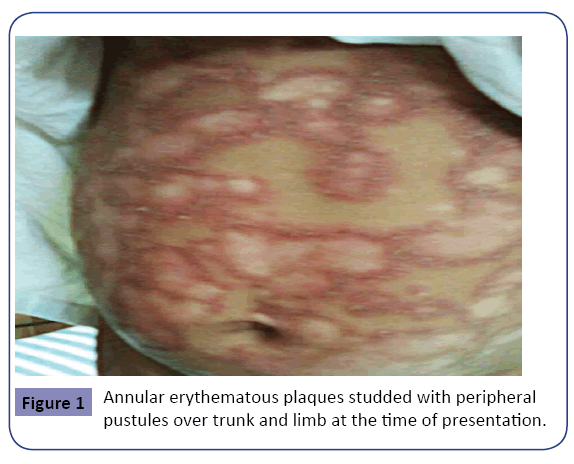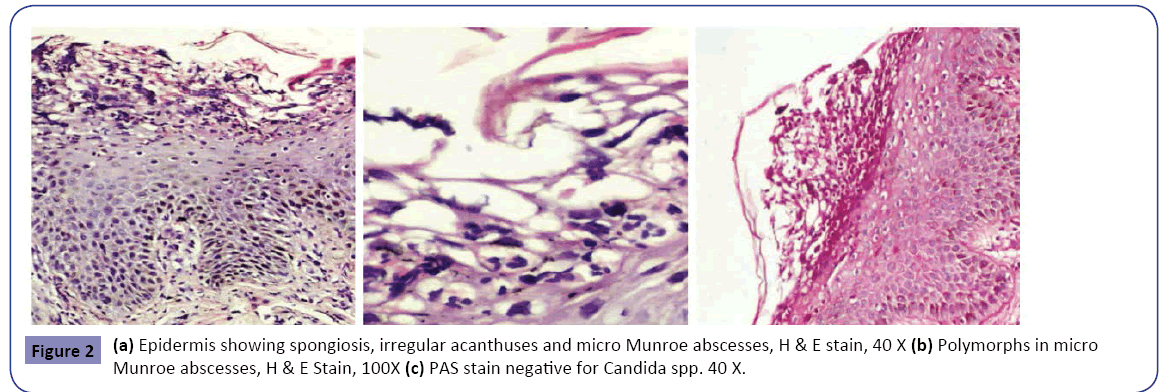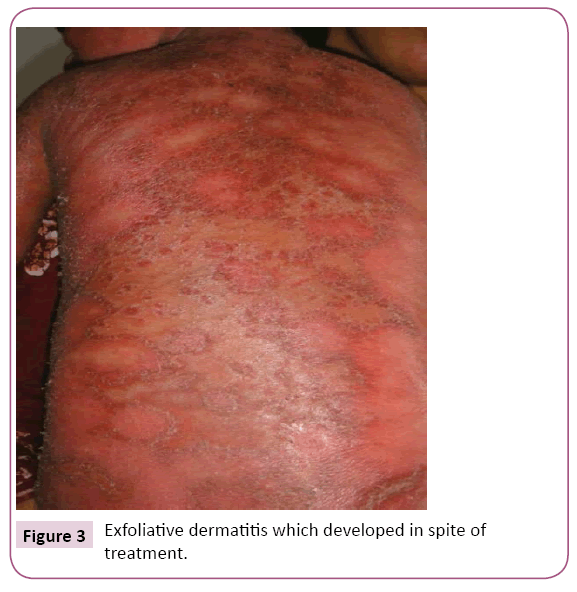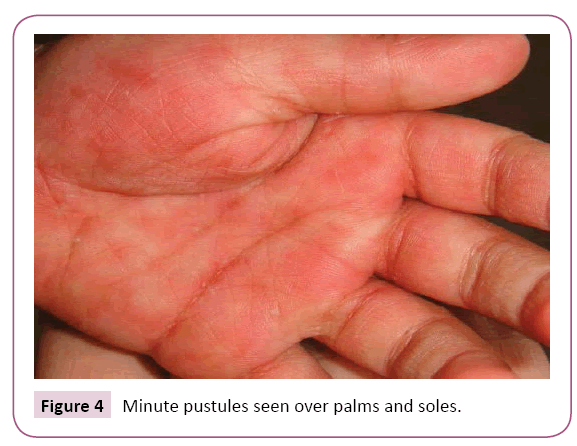Neema Ali M1*, Upadya G2, Kumar P2 and Kuruvila M2
1Department of Dermatology, Father Muller Medical College, Mangalore, Karnataka, India
2Department of Dermatology, Kasturba Medical College, Mangalore, Karnataka, India
*Corresponding Author:
Neema Ali M
Department of Dermatology, Father Muller Medical College, Mangalore, Karnataka, India
Tel: 91-8971897370
E-mail: dr.neema.m.ali@gmail.com
Received Date: March 03, 2016; Accepted Date: March 22, 2016; Published Date: March 28, 2016
Citation: Neema Ali M, Upadya G, Kumar P, et al. Exfoliative Dermatitis Secondary to Acute Generalized Pustular Psoriasis in a Child: A Case Report. Clin Pediatr Dermatol. 2016, 2:2 Doi: 10.21767/2472-0143.100015
Keywords
Psoriasis; Erythroderma; Systemic therapy
Introduction
Psoriasis is a common T-lymphocyte mediated inflammatory dermatosis in children. Infantile psoriasis is rare and accounts for only 3.5%-16% of childhood psoriasis [1]. General pustular psoriasis (GPP), an extremely rare form of psoriasis first described in 1910 by Leo Ritter von Zumbusch, is characterized by an abrupt onset of widespread erythematous lesions followed by superficial yellowish, usually confluent sterile pustules, accompanied by constitutional symptoms such as fatigue and fever [2]. Four clinical patterns of pustular psoriasis have been described: von Zumbusch, also known as generalized (GPP), annular (APP), exanthematic, and localized. A mixed variant (MPP), demonstrating features of both the von Zumbusch and annular patterns, has also been described [3]. Pustular psoriasis (PP) is a severe form of psoriasis and is extremely rare during the first decade of life. Only 1.0% to 5.4% of children have pustular psoriasis [4]. Early diagnosis with appropriate treatment is necessary to prevent the affected infants from severe complications, such as bacterial superinfection, dehydration, and sepsis [5].
Case Report
A two and a half year old female child presented with itchy, erythematous, annular plaques involving the trunk and limbs, of 1 month duration. This was associated with a history of low-grade fever of 10 days duration. Minute pustules studded the edges of the plaque. The lesions started over the buttocks, which spread to involve the trunk and limbs over a period of two weeks. She was treated with antifungals in a local hospital, with no relief. An episode of acute ear infection preceded the onset of skin lesions.
Tracing back her illness, there is a past history of similar lesions over trunk at 28 days of age which developed into erythroderma over a period of 2 weeks requiring hospital admission. A provisional diagnosis of exfoliative dermatitis secondary to atopic dermatitis or seborrheic dermatitis was made. She improved on treatment with antibiotics, topical emollients and mild topical steroids, and was not investigated further. She has been symptom free since then, until the onset of the current episode 1 month ago. There is no family history of atopy or psoriasis or any other skin diseases. On examination, the child was febrile with a temperature of 101°F. The systemic examination was within normal limits. Generalized lymphadenopathy was present. Cutaneous examination revealed erythematous scaly plaques over both cheeks. Multiple lesions were present on the trunk, neck, and extremities, with both solitary and confluent plaques. Well-defined annular erythematous plaques studded with peripheral pustules were seen (Figure 1).

Figure 1: Annular erythematous plaques studded with peripheral pustules over trunk and limb at the time of presentation.
Examination of scalp revealed thick adherent scaling seen over entire scalp. Geographic tongue was seen on oral cavity examination. A differential diagnosis of acute generalized pustular psoriasis and generalized cutaneous candidiasis was made.
Investigations showed raised total leucocyte counts. Liver and renal function tests were within normal limits. Serum IgE levels were normal. Gram stain showed neutrophils. Scraping for fungus from the edge of the lesion did not show any fungal elements. Pus culture showed a moderate growth of Staphylococcus aureus. A skin biopsy showed spongiosis, irregular acanthosis of epidermis with micro Munroe abscesses. Dermis showed perivascular lymphocytic infiltration (Figure 2a and 2b). A PAS stain was done which was negative for candida (Figure 2c). In view of the clinical findings, and the presence of neutrophilic micro abscesses on histopathological examination, a diagnosis of annular type of generalized pustular psoriasis was made. The patient was treated with oral cephalosporins, topical steroids and oral antihistamines Patient showed improvement and discharged after 5 days of hospital admission.

Figure 2: (a) Epidermis showing spongiosis, irregular acanthuses and micro Munroe abscesses, H & E stain, 40 X (b) Polymorphs in micro Munroe abscesses, H & E Stain, 100X (c) PAS stain negative for Candida spp. 40 X.
A week later she presented to the OPD with generalized redness and scaling of the entire body was associated with low-grade fever. Cutaneous examination showed generalized erythema and scaling of entire body (>90% BSA), thick adherent scales over extensor aspect of both arms (Figure 3) and numerous minute pustules seen mainly over trunk, and palms and soles (Figure 4).

Figure 3: Exfoliative dermatitis which developed in spite of treatment.

Figure 4: Minute pustules seen over palms and soles.
A central IV line was secured in view of generalized skin involvement. Oral cyclosporine 2 mg/kg/day was started after baseline investigations of total counts, serum potassium levels, liver and renal function tests and baseline blood pressure measurement. RFT, CBC, K+ levels were then monitored weekly. She was continued to be treated with antibiotics, antihistamines, emollients and mild topical steroids. Her lesions improved over the next 2 weeks and she was discharged with the advice to continue oral cyclosporine 2 mg/kg/day.
Three days later, she reported to the OPD with increased redness and thick scales over the entire body. But there were no new pustules at this point of time. The dose of cyclosporine was increased to 4 mg/kg/day. She was also started on oral deflazacort 1 mg/kg/day along with continued use of antibiotics, antihistamines, emollients and mild topical steroids. Narrow band UVB phototherapy was initiated as an adjunct to maintain remission but it was discontinued after just a single sitting as the patient developed severe erythema and itching. She responded well to the treatment and was discharged on 12th day of admission with the advice to continue cyclosporine and a tapering dose of deflazacort.
On 2 week follow up, she was in continued remission. A month later, nifedipine was added because she developed hypertension secondary to cyclosporine and the cyclosporine dosage was tapered to 2 mg/kg/day. She was in continued remission during the subsequent monthly visits for a period of 3 months, but she was then lost to follow up.
Discussion
A population-based study [6], reveals that the annual incidence of childhood psoriasis is 33.2 cases per 100,000 children. Child psoriasis affects 0.71% of the population under 18 and its prevalence increases linearly with age [7]. Pustular psoriasis is a severe form of psoriasis and is extremely rare during the first decade of life. Only 1%-5.4% of children have pustular psoriasis. Four distinct patterns have been described: generalized or von Zumbusch, annular, exanthematic or localized [4]. This patient presented with annular variant of pustular psoriasis but later developed exfoliative dermatitis in spite of timely initiation of therapy. The clinical differential diagnosis of annular eruptions in childhood is broad and includes common conditions such as tinea corporis, nummular atopic dermatitis, granuloma annulare, urticaria, erythema multiforme, and erythema annulare centrifugum.
The main triggering factors of psoriasis in children are infections, especially beta hemolyticstreptococcal pharyngitis, stress and trauma [7]. The acute ear infection seems to be the triggering episode in our patient. She presented with an annular variant of pustular psoriasis. The annular variant of pustular psoriasis occurs in both adults and children, but review of the literature reveals a relatively higher proportion of children [3] But later on she developed erythroderma, and had several minute pustules all over her body and also the palms and soles. She most likely had a mixed variant of pustular psoriasis, demonstrating features of both the von Zumbusch and annular patterns.
Erythroderma is a well-recognized entity in the adult age group, but there are few studies on erythroderma in the pediatric age group. This case is even more unique because of erythroderma secondary to pustular psoriasis in a child of such a young age.
The choice of treatment in infantile psoriasis should be determined by age, gender, weight, distribution of the lesions, associated symptoms and signs, and comorbidities. Because of young age, topical emollients and corticosteroids are usually the first option. Other agents are also found to be effective in infantile psoriasis, including topical calcipotriol (calcipotriene) and topical pimecrolimus. For generalized pustular psoriasis, however, the disease course is usually fulminant and prolonged [1].
A systematic review of systemic medications for pustular psoriasis in pediatrics treatment 4 found that the treatment of pediatric pustular psoriasis is challenging. Therapies most commonly used to control pediatric generalized pustular psoriasis-acitretin, cyclosporine, and methotrexate— did not differ in their shortterm effect. Retinoids have been recommended for short-term treatment in pustular or erythrodermic psoriasis in infants and male adolescents. Cyclosporine is useful in controlling the acute phase of psoriasis unresponsive to other therapies because of its rapid onset of action and serves as a temporary treatment before initiating medium- to long-term therapy [4].
Cyclosporine is a cyclic endecapeptide of fungal origin used as an immunopresent. There apprear to be several ways in which cyclosporine can exert its effect as an antipsoriatic drug: Ca2+ signal modulation, inhibition of membrane phospholipid metabolism, interference with cell surface receptors, inhibition of lymphokine production or inhibition of MHC (major histocompatibility) class II expression [8]. Our patient was started on oral cyclosporine 2 mg/kg/day. In a study [9], of effect of cyclosporine treatment in generalized pustular psoriasis, patients responded to cyclosporine 2 mg/kg/day within 2 weeks. Our patient showed improvement with the same dosage in a similar time span, but in spite of this progressed to erythroderma while still on treatment after she was discharged. On her second hospital admission, her cyclosporine dosage was increased. UVB phototherapy of 311 nm is inappropriate during febrile illnesses, but has been demonstrated as effective adjunctive therapy for maintenance of GPP [2]. But in her case, it had to be discontinued as she developed erythema and severe itching after a single sitting of phototherapy. This patient achieved remission after 4 weeks of treatment (Figure 5) with cyclosporine and was on continued remission at 3 month follow up.

Figure 5: Resolution of lesions after 4 weeks of cyclosporine therapy.
The goal of the therapy is not only to control an acute exacerbation but also to achieve durable remission with improvement in patient’s quality of life. Because of rarity of the disease especially in children, the evidence-based information is extremely limited. Experts’ recommendations support systemic retinoids, methotrexate, and cyclosporine as first-line systemic therapy in GPP children [2,10].
In summary, childhood pustular psoriasis is uncommon and may pose a diagnostic and therapeutic challenge. We report a child with pustular psoriasis preceded by an acute ear infection, whose disease, even with timely intervention progressed to erythroderma but later went into remission with higher doses of cyclosporine. As children are at a stage of rapid growth, timely diagnosis and appropriate treatment is essential to ensure that the disease process does not interfere with their normal development.
References
- Su YS, Chen G, Lan EC (2011) Infantile generalized pustular psoriasis: a case report andreview of the literature. Dermatologica Sinica 29: 22-24.
- Fialova J, Vojackova N, Vanousova D, Hercogova J (2014) Juvenile generalized pustular psoriasis treated with etanercept. Dermatological therapy 27:105-108.
- Liao PB, Rubinson R, Howard R, Sanchez G, Frieden IJ (2002) Annular pustular psoriasis. Most common form of pustul ar psoriasis in children: Report of three cases and review of the literature. Pediatric Dermatology19:19-25.
- Posso-De Los Rios CJ, Pope E, Corrales L (2014) A systematic review of systemic medications for pustular psoriasis in pediatrics. Pediatric Dermatology 31: 430-439.
- Kopp T, Karlhofer F, Szepfalusi Z(2004) Successful use of acitretin in conjunction with narrowband ultraviolet B phototherapy in a child with severe pustular psoriasis, von Zumbusch type. Br J Dermatol151:912-916.
- Tollefson MM, Crowson CS, McEvoy MT, Maradit Kremers H (2010) Incidence of psoriasis in children: a population-based study. J Am Acad Dermatol 62:979- 987.
- Fraga S, Naiara A, Fátima M, Nogueira A, Vitória A, et al. (2011) Refractory erythrodermic psoriasis in a child with an excellent outcome by using etanercept. Anais Brasileiros de Dermatologia 86:144-147.
- Bos JD (1988) The pathomechanisms of psoriasis: skin immune system and cyclosporine. Br J Dermatol118:141-155.
- Kilic SS, Hacimustafaoglu M, Celebi S, Karadeniz A, Ildirim I (2001) Low dose cyclosporine A treatment in generalized pustular psoriasis. Paediatric dermatology 18: 246-248.
- Patil JD, Chaudhary SS, Rani N, Mishra AK (2014) Follicular psoriasis causing erythroderma in a child: A rare presentation. Indian Dermatol Online J 5: 63-65.






